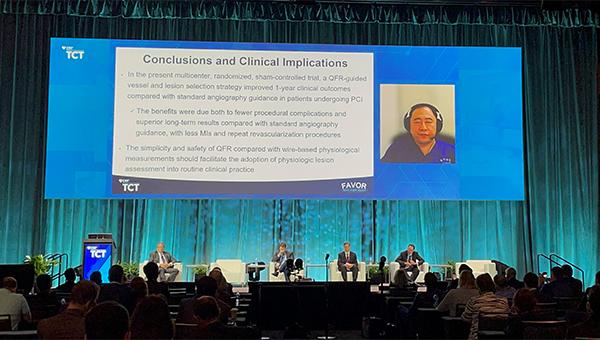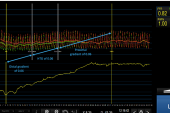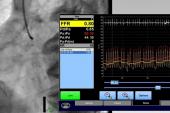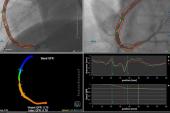FAVOR III China Adds Strength to Value of QFR-Guided PCI
The simulated measurement led to fewer interventions and fewer MACE compared with visual angiography-based assessment.

(UPDATED) Compared with visual lesion assessment of the angiogram, using quantitative flow ratio (QFR) to guide PCI results in better clinical results at 1 year, the FAVOR III China study finds.
“The simplicity and safety of QFR compared with wire-based physiological measurements should facilitate the adoption of physiologic lesion assessment into routine clinical practice,” said Bo Xu, MBBS, (Fuwai Hospital, Beijing, China), who presented the results in a late-breaking trial session today at TCT 2021. They also were simultaneously published in the Lancet.
Despite recommendations from the 2018 European Society of Cardiology and European Association for Cardio-Thoracic Surgery guidelines to use pressure wire-based fractional flow reserve (FFR) measurement, Xu and colleagues say, it is largely underused in practice for a variety of reasons, including prolonged procedure times, potential complications from using the pressure wire, side effects from hyperemic agents, and cost. By contrast, QFR can be derived from three-dimensional coronary artery reconstruction and fluid dynamics from the angiogram, thereby estimating FFR without the use of a pressure wire or hyperemic drugs.
Among the 3,847 patients with stable or unstable CAD enrolled at 26 hospitals in China, the rate of 1-year MACE (a composite of death from any cause, MI, or ischemia-driven revascularization) was lower among those randomized to a QFR-guided strategy rather than an angiography-guided strategy based on visual assessment (5.8% vs 8.8%; P = 0.0004), Xu reported. The difference was driven primarily by fewer MIs in the QFR-guided group, which translated to 44 fewer events (P = 0.0008).
In a commentary accompanying the published paper, Robert A. Byrne, MBBCh, PhD, and Laurna McGovern (both Mater Private Hospital, Dublin, Ireland), note that the findings are an important step forward for angiography-derived flow measurements to guide PCI, as decision-making “continues to move away from assessment based on anatomical stenosis severity alone.” While the FAVOR III China results strengthen the evidence supporting a benefit of physiological guidance versus angiography-guided PCI, Byrne and McGovern point out that a major limitation of the study is that the control group did not receive pressure wire-guided PCI. The protocol did not allow operators the option of using pressure wire in either treatment group.
However, Taku Asano, MD, PhD (St. Luke’s International Hospital, Tokyo, Japan), who commented on the results for TCTMD, noted that in cath labs where a pressure wire is not available for some reason, QFR could be seen as a breakthrough.
“Even if operators have an option of wire-based physiological assessment, QFR is still a viable option for the functional assessment because it is a less invasive tool compared to wire-based physiological indice,” he said. A potential drawback, however, is that QFR is not a perfect simulation.
“I don’t think all operators who judge the PCI indication based on FFR in daily practice will totally accept this FFR simulation for the important treatment decision-making, because patients receiving stents have some risk for periprocedural myocardial infarction and require [dual antiplatelet therapy] for a certain period,” Asano said. In some cases, he added, operators may consider it worth the additional time and risk to use a pressure wire assessment to acquire a true value.
Moreover, Byrne and McGovern suggest that up to 20% of patients may not even be unsuitable for the QFR strategy due to coronary anatomy, presence of overlapping vessels, and insufficient image quality.
To TCTMD, Xu acknowledged that some of his colleagues had similar concerns about QFR prior to the trial. However, he said the mean time that it took to obtain the measurement via QFR was only 3.6 minutes, with more than 97% of the coronary angiograms being suitable for use. Overall, he said his opinion is that QFR is “very, very feasible in routine practice.”
More Changes to Treatment Strategy With QFR
In FAVOR III China, patients were randomly assigned to either the QFR-guided (n = 1,913) or angiography-guided arm (n = 1,912) if they had at least one lesion with a diameter stenosis of 50% to 90% with a reference vessel diameter of at least 2.5 mm. Vessels that were intended to be treated were identified by operators prior to randomization.
With the QFR-guided strategy, all coronary arteries were measured and PCI was only performed if QFR was ≤ 0.80 or diameter stenosis was > 90%. The estimation was made in real time using 3D reconstruction and computational fluid dynamics from the angiogram without the need for pressure wires or induction of hyperemia. Operators performed two angiographic imaging runs and the data were transmitted to the AngioPlus system (Pulse Medical Imaging Technology) by a local network of sites for QFR computation.
QFR guidance changed the planned strategy in nearly one-quarter of patients, leading to fewer vessels being treated, less stenting, and less contrast use than with angiography guidance. For example, deferral of at least one vessel originally intended for PCI occurred in 19.6% of patients in the QFR arm versus 5.2% in the angiography arm, while treatment of at least one vessel not intended for PCI occurred in 4.4% versus 1.5% (P < 0.0001 for both comparisons). Additionally, more patients in the QFR arm had a residual functional SYNTAX score of 0 than in the angiography-guided arm (88.1% vs 82.2%; P < 0.0001).
Rates of nonprocedural MI were 1.6% at 1 year in the angiography-guided arm and 0.5% in the QFR-guided arm (P = 0.0015), while rates of ischemia-driven revascularization were 3.1% vs 2.0% (P = 0.030).
In a press conference prior to the presentation, Giuseppe Tarantini, MD, PhD (University of Padua, Italy), called the findings “remarkable,” adding that he wouldn’t be surprised to see QFR added to the next practice guideline.
“This is a milestone in our community, not only because it is easier to use compared to other lesion-specific index, like FFR, but also to expand the use of physiology in the setting of interventional cardiology,” Tarantini said.
Asano added that using a pressure wire in daily practice faces a big hurdle in many situations where QFR could be an effective solution.
Although current QFR technology requires two projections for each vessel, Xu and colleagues say the next generation of the system will require only a single projection and incorporate more automation, which they say should “further reduce analysis variability and time.”
Following the presentation in the late-breaking trial session, moderator Gregg Stone, MD (Icahn School of Medicine at Mount Sinai, New York, NY), noted that given the negative findings for FFR in both FAME 3 and FLOWER-MI, “you wonder, is physiology leading us in the wrong direction? But here's a very positive trial for physiologic guidance.”
Panelist Nils Johnson, MD (McGovern Medical School at UT Health, Houston, TX), stressed that vessel-level analyses will be critical to further understanding the role of QFR-estimated FFR. Even though only one out of four lesions in FAVOR III China were QFR negative, “the entire difference in these event curves is completely driven by the QFR-negative lesions that were randomized to medical therapy in the one arm or randomized to PCI in the other,” he observed.
Xu agreed. “I think it's very important to compare the vessel-level adverse events with the intended vessel and nonintended vessel, so we can see if the periprocedural MI was similar between all treated vessels,” he said.
L.A. McKeown is a Senior Medical Journalist for TCTMD, the Section Editor of CV Team Forum, and Senior Medical…
Read Full BioSources
Xu B, Tu S, Song L, et al. Angiographic quantitative flow ratio-guided coronary intervention (FAVOR III China): a multicentre, randomized, sham-controlled trial. Lancet. 2021;Epub ahead of print.
Byrne RA, McGovern L. Angiography-derived quantitative flow ratio guidance of coronary intervention: measure twice, cut once. Lancet. 2021;Epub ahead of print.
Disclosures
- Xu reports grant/research support from Beijing Municipal Science and Technology Commission, Chinese Academy of Medical Sciences, and the National Clinical Research Center for Cardiovascular Diseases, Fuwai Hospital.
- Byrne reports research or educational funding to his institution from Abbott Vascular, Biosensors, Biotronik, and Boston Scientific.
- McGovern and Asano reports no relevant conflicts of interest.





Comments